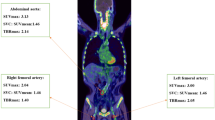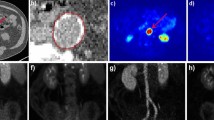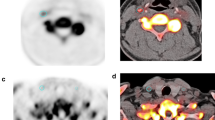Abstract
Purpose
To compare F-18-fluoro-2-deoxy-D-glucose (F-18 FDG) positron emission tomography/computed tomography (PET/CT) imaging at two different circulation times after injection of F-18 FDG in order to measure atherosclerosis in carotid arteries.
Methods
We assessed 12 patients with recent symptomatic plaques in the carotid arteries. F-18 FDG PET/CT carotid plaque imaging was performed for 20 min at 2 h after F-18 FDG injection in five patients and at 3 h in seven patients. We measured vessel wall uptake using the maximal standardized uptake value (SUV), and the mean and maximal blood target-to-background ratios (TBR) of the symptomatic carotid arteries. Blood pool activity (BPA) was measured as the mean SUV of the superior vena cava (SVC) and jugular vein of these 12 patients, and in 14 age- and gender-matched patients who underwent whole-body F-18 FDG PET/CT examinations 1 h after injection.
Results
F-18 FDG PET/CT revealed visible F-18 FDG uptake in all patients with symptomatic carotid plaques. Maximal SUV did not differ between groups evaluated at 2 h and 3 h (2.62 ± 0.45 vs 3.00 ± 0.85, p = 0.335). However, mean (2.04 ± 0.22 vs 3.54 ± 0.62, p < 0.05) and maximal (1.65 ± 0.15 vs 2.70 ± 0.42, p < 0.05) TBR values that were normalized to BPA in the SVC differ significantly.
Conclusions
Symptomatic carotid plaques are visualized for a relatively short period of imaging time on ≥1-h PET/CT images. Quantitative parameters of atherosclerotic carotid arteries are preserved or even increased over time, whereas those of blood pools are decreased.


Similar content being viewed by others
References
Davies MJ, Thomas AC (1985) Plaque fissuring—the cause of acute myocardial infarction, sudden ischaemic death, and crescendo angina. Br Heart J 53:363–373
Izquierdo-Garcia D, Davies JR, Graves MJ, Rudd JH, Gillard JH, Weissberg PL et al (2009) Comparison of methods for magnetic resonance-guided [18-F]fluorodeoxyglucose positron emission tomography in human carotid arteries: reproducibility, partial volume correction, and correlation between methods. Stroke 40:86–93
Aziz K, Berger K, Claycombe K, Huang R, Patel R, Abela GS (2008) Noninvasive detection and localization of vulnerable plaque and arterial thrombosis with computed tomography angiography/positron emission tomography. Circulation117:2061–2070
Tawakol A, Migrino RQ, Hoffmann U, Abbara S, Houser S, Gewirtz H et al (2005) Noninvasive in vivo measurement of vascular inflammation with F-18 fluorodeoxyglucose positron emission tomography. J Nucl Cardiol 12:294–301
Chen W, Bural GG, Torigian DA, Rader DJ, Alavi A (2009) Emerging role of FDG-PET/CT in assessing atherosclerosis in large arteries. Eur J Nucl Med Mol Imaging 36:144–151
Rudd JH, Warburton EA, Fryer TD, Jones HA, Clark JC, Antoun N et al (2002) Imaging atherosclerotic plaque inflammation with [18F]-fluorodeoxyglucose positron emission tomography. Circulation 105:2708–2711
Davies JR, Rudd JH, Fryer TD, Graves MJ, Clark JC, Kirkpatrick PJ et al (2005) Identification of culprit lesions after transient ischemic attack by combined 18F fluorodeoxyglucose positron-emission tomography and high-resolution magnetic resonance imaging. Stroke 36:2642–2647
Menezes LJ, Kotze CW, Hutton BF, Endozo R, Dickson JC, Cullum I et al (2009) Vascular inflammation imaging with 18F-FDG PET/CT: when to image? J Nucl Med 50:854–857
Townsend DW (2008) Dual-modality imaging: combining anatomy and function. J Nucl Med 49:938–955
Okane K, Ibaraki M, Toyoshima H, Sugawara S, Takahashi K, Miura S et al (2006) 18F-FDG accumulation in atherosclerosis: use of CT and MR co-registration of thoracic and carotid arteries. Eur J Nucl Med Mol Imaging 33:589–594
Panin VY, Kehren F, Michel C, Casey M (2006) Fully 3-D PET reconstruction with system matrix derived from point source measurements. IEEE Trans Med Imaging 25:907–921
Rudd JH, Myers KS, Bansilal S, Machac J, Rafique A, Farkouh M et al (2007) (18)Fluorodeoxyglucose positron emission tomography imaging of atherosclerotic plaque inflammation is highly reproducible: implications for atherosclerosis therapy trials. J Am Coll Cardiol 50:892–896
Rudd JH, Elkhawad M, Fayad ZA (2009) Vascular imaging with 18F-FDG PET/CT: optimal 18F-FDG circulation time? J Nucl Med 50:1560; author reply 1560-1561
Wu YW, Kao HL, Chen MF, Lee BC, Tseng WY, Jeng JS et al (2007) Characterization of plaques using 18F-FDG PET/CT in patients with carotid atherosclerosis and correlation with matrix metalloproteinase-1. J Nucl Med 48:227–233
Arauz A, Hoyos L, Zenteno M, Mendoza R, Alexanderson E (2007) Carotid plaque inflammation detected by 18F-fluorodeoxyglucose-positron emission tomography. Pilot study. Clin Neurol Neurosurg 109:409–412
Tawakol A, Migrino RQ, Bashian GG, Bedri S, Vermylen D, Cury RC et al (2006) In vivo 18F-fluorodeoxyglucose positron emission tomography imaging provides a noninvasive measure of carotid plaque inflammation in patients. J Am Coll Cardiol 48:1818–1824
Tahara N, Kai H, Ishibashi M, Nakaura H, Kaida H, Baba K et al (2006) Simvastatin attenuates plaque inflammation: evaluation by fluorodeoxyglucose positron emission tomography. J Am Coll Cardiol 48:1825–1831
Tahara N, Kai H, Yamagishi S, Mizoguchi M, Nakaura H, Ishibashi M et al (2007) Vascular inflammation evaluated by [18F]-fluorodeoxyglucose positron emission tomography is associated with the metabolic syndrome. J Am Coll Cardiol 49:1533–1539
Ogawa M, Magata Y, Kato T, Hatano K, Ishino S, Mukai T et al (2006) Application of 18F-FDG PET for monitoring the therapeutic effect of antiinflammatory drugs on stabilization of vulnerable atherosclerotic plaques. J Nucl Med 47:1845–1850
Font MA, Fernandez A, Carvajal A, Gamez C, Badimon L, Slevin M et al (2009) Imaging of early inflammation in low-to-moderate carotid stenosis by 18-FDG-PET. Front Biosci 14:3352–3360
So Y, Chung JK, Jeong JM, Lee DS, Lee MC (2005) Usefulness of additional delayed regional F-18 fluorodeoxy-glucose positron emission tomography in the lymph node staging of non-small cell lung cancer patients. Cancer Res Treat 37:114–121
Acknowlegements
This study was supported by a grant (2009-365) from the Asan Institute for Life Sciences, Seoul, Republic of Korea.
Author information
Authors and Affiliations
Corresponding author
Rights and permissions
About this article
Cite this article
Oh, M., Kim, J.Y., Shin, KH. et al. Imaging Atherosclerosis in the Carotid Arteries with F-18-Fluoro-2-deoxy-D-glucose Positron Emission Tomography: Effect of Imaging Time after Injection on Quantitative Measurement. Nucl Med Mol Imaging 44, 261–266 (2010). https://doi.org/10.1007/s13139-010-0043-y
Received:
Accepted:
Published:
Issue Date:
DOI: https://doi.org/10.1007/s13139-010-0043-y




